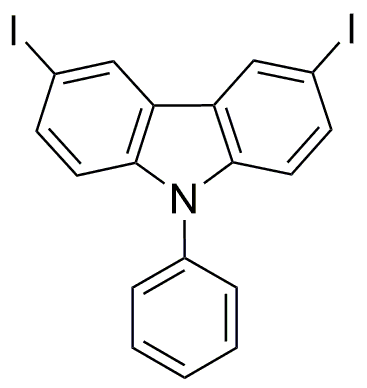3,6-Diiodo-9-phenylcarbazole is widely utilized in research focused on:
- Organic Electronics: This compound is a key material in organic light-emitting diodes (OLEDs), enhancing device efficiency and color purity, which is crucial for high-quality displays.
- Photovoltaic Cells: It serves as a semiconductor in organic solar cells, improving energy conversion efficiency and offering a lightweight alternative to traditional materials.
- Fluorescent Probes: Used in biological imaging, it acts as a fluorescent probe for tracking cellular processes, providing researchers with valuable insights into cell behavior.
- Anticancer Research: The compound has shown potential in developing new anticancer agents, with studies indicating its ability to inhibit tumor growth, making it a focus for pharmaceutical research.
- Material Science: It is explored for its properties in creating advanced materials, such as polymers with enhanced thermal stability and electrical conductivity, beneficial for various industrial applications.
Informations générales
Propriétés
Sécurité et réglementation
Applications
3,6-Diiodo-9-phenylcarbazole is widely utilized in research focused on:
- Organic Electronics: This compound is a key material in organic light-emitting diodes (OLEDs), enhancing device efficiency and color purity, which is crucial for high-quality displays.
- Photovoltaic Cells: It serves as a semiconductor in organic solar cells, improving energy conversion efficiency and offering a lightweight alternative to traditional materials.
- Fluorescent Probes: Used in biological imaging, it acts as a fluorescent probe for tracking cellular processes, providing researchers with valuable insights into cell behavior.
- Anticancer Research: The compound has shown potential in developing new anticancer agents, with studies indicating its ability to inhibit tumor growth, making it a focus for pharmaceutical research.
- Material Science: It is explored for its properties in creating advanced materials, such as polymers with enhanced thermal stability and electrical conductivity, beneficial for various industrial applications.
Documents
Fiches de données de sécurité (FDS)
La FDS fournit des informations de sécurité complètes sur la manipulation, le stockage et l’élimination du produit.
Spécifications du produit (PS)
Le PS fournit une description complète des propriétés du produit, notamment sa composition chimique, son état physique, sa pureté et les exigences de stockage. Il détaille également les plages de qualité acceptables et les applications prévues du produit.
Certificats d'analyse (COA)
Recherchez des certificats d'analyse (COA) en saisissant le numéro de lot du produit. Les numéros de lot et de lot se trouvent sur l'étiquette d'un produit, après les mots « Lot » ou « Lot de fabrication ».
Numéro de catalogue
Numéro de lot/série
Certificats d'origine (COO)
Ce certificat d'exploitation confirme le pays dans lequel le produit a été fabriqué, et détaille également les matériaux et composants utilisés et s'il est issu de sources naturelles, synthétiques ou autres sources spécifiques. Ce certificat peut être requis pour les douanes, le commerce et la conformité réglementaire.
Numéro de catalogue
Numéro de lot/série
Fiches de données de sécurité (FDS)
La FDS fournit des informations de sécurité complètes sur la manipulation, le stockage et l’élimination du produit.
DownloadSpécifications du produit (PS)
Le PS fournit une description complète des propriétés du produit, notamment sa composition chimique, son état physique, sa pureté et les exigences de stockage. Il détaille également les plages de qualité acceptables et les applications prévues du produit.
DownloadCertificats d'analyse (COA)
Recherchez des certificats d'analyse (COA) en saisissant le numéro de lot du produit. Les numéros de lot et de lot se trouvent sur l'étiquette d'un produit, après les mots « Lot » ou « Lot de fabrication ».
Numéro de catalogue
Numéro de lot/série
Certificats d'origine (COO)
Ce certificat d'exploitation confirme le pays dans lequel le produit a été fabriqué, et détaille également les matériaux et composants utilisés et s'il est issu de sources naturelles, synthétiques ou autres sources spécifiques. Ce certificat peut être requis pour les douanes, le commerce et la conformité réglementaire.


